Recover Unsaved Workbooks
July 21, 2017 - by Bill Jelen

Thanks to Office MVP Beth Melton for rounding out my knowledge of this trick.
The Auto Recover feature is a lifesaver. It is turned on automatically in Excel 2010 and newer.
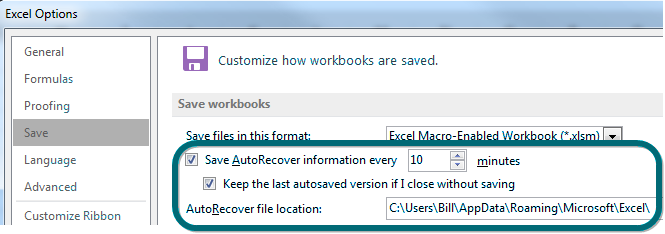
Say it is 4:59 PM on Friday, and you are trying to get the heck out of work. You have a bunch of files open in Excel and issue the Alt + F + X command to exit Excel.
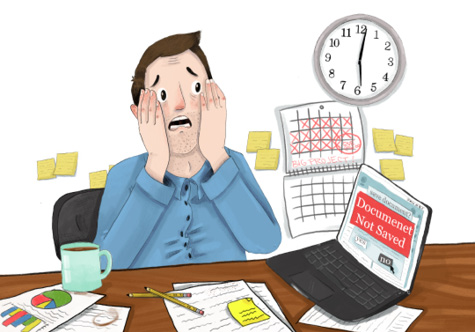
Illustrator: Sarah Lucia Jones
Standing between you and the after-work PowerPivotini happy hour are a bunch of dialogs like this one:
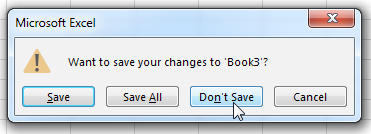
There is no need to save this file, so you click Don't Save.
Next file? Don't Save.
Next file? Don't Save.
Now you are in a rhythm, clicking Don't Save in perfect synchronization with Excel presenting the message. Then, as you click Don't Save the last time, you realize that this workbook had a lot of unsaved changes. And you really needed to save it. You should have clicked Save.
You look at your watch. It will take two hours to re-create all of those changes. Your happy hour plans are sunk. But wait! Excel has your back. If the workbook was open for at least 10 minutes and went through an AutoSave, Excel kept a copy for you.
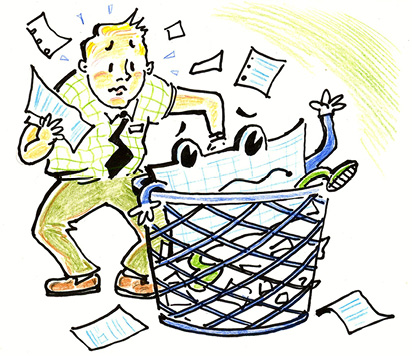
Walter Moore
Follow these steps to get it back:
- Hold your breath.
- Open Excel.
-
In the left panel, all the way at the bottom, choose Open Other Workbooks.

Open Other Workbooks -
In the center panel, scroll all the way to the bottom of the recent files. At the very end, click Recover Unsaved Workbooks.

Recover Unsaved Workbooks -
Excel shows you all the unsaved workbooks that it has saved for you recently.
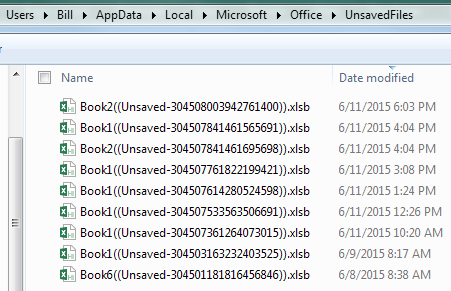
Unsaved Files List - Click one and choose Open.
- If it is the wrong one, go back to File, Open and scroll to the bottom of the list.
-
When you find the right file, click the Save As button to save the workbook.

REcovered Unsaved File
Unsaved workbooks are saved for four days before they’re automatically deleted.
Using AutoSave Versions to Recover Files Previously Saved
This might seem confusing, but Recover Unsaved Workbooks applies only to files that have never been saved. If your file has been saved, you will use AutoSave versions to get the file back.
If you close a previously saved workbook without saving recent changes, one single AutoSave version is kept until your next editing session. To access it, reopen the workbook. Use File, Info, Versions to open the last AutoSave version.
You can also search for the last AutoSave version using Windows Explorer. Excel Options specifies an AutoRecover File Location. (See the first screenshot in this topic). If your file was named Budget2018Data, look for a folder within the AutoRecover File folder that starts with Budget.
While you are editing a workbook, you can access up to the last five AutoSave versions of a previously saved workbook. These can be opened on the Info tab under the Versions section. You may make changes to a workbook and want to reference what you previously had. Instead of trying to Undo a bunch of revisions, or using Save As to save as a new file, you can open an AutoSave version. AutoSave versions will open in another window so you can reference, copy/paste, save it as a separate file, etc.
Note
An AutoSave version is created according to the AutoRecover interval AND only if there are changes. So if you leave a workbook open for two hours without making any changes, the last AutoSave version will contain the last revision.
Caution
Both the Save AutoRecover Information option and Keep The Last AutoSaved Version option must be selected in order to recover an AutoSave version.
Note
Under the Manage Version options on the Info tab is the ability to Delete All Unsaved Workbooks. This is an important option to know about if you work on public computers. You may want to make sure you don’t leave copies of your work behind. Note that this option only appears if you’re working on a file that has never been previously saved. The easiest way to access it is to create a new workbook.
Thanks to Beth Melton and Paul Seaman and for clarifying the differences between AutoRecover and Recover Unsaved Files.
Watch Video
- Thanks to Office MVP Beth Melton for rounding out my knowledge of this trick.
- Workbooks that never had a name
- You have a new workbook. You make changes. The workbook gets through an AutoSave
- You close without saving.
- When you open Excel scroll all the way down to find Recover Unsaved Workbooks
- Workbooks that did have a name
- You open a workbook. You make changes. The workbook gets through an AutoSave
- You close without saving.
- Normally Excel keeps last five autosave versions (one every 10 minutes provided there has been a change)
- When you close without saving all are lost except the last version.
- Go to File Info within first 10 minutes to get the last autosaved version
Download File
Download the sample file here: Podcast1988.xlsx
Title Photo: PublicDomainPictures / pixabay
